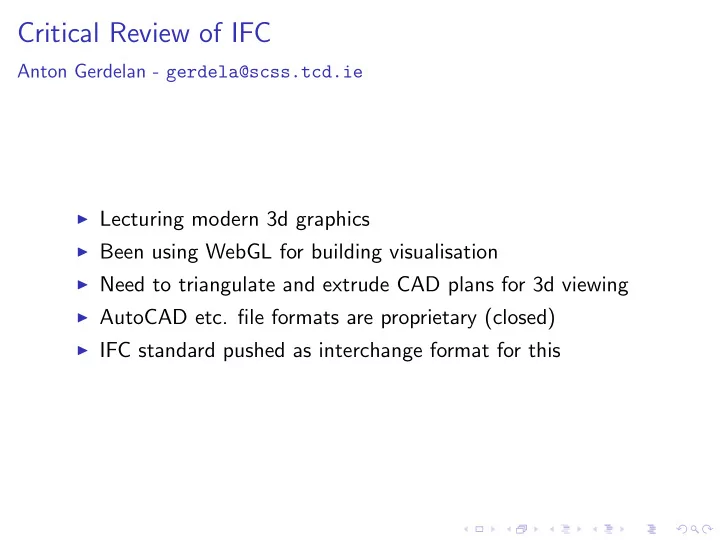

Critical Review of IFC Anton Gerdelan - gerdela@scss.tcd.ie ◮ Lecturing modern 3d graphics ◮ Been using WebGL for building visualisation ◮ Need to triangulate and extrude CAD plans for 3d viewing ◮ AutoCAD etc. file formats are proprietary (closed) ◮ IFC standard pushed as interchange format for this
3d Mesh Formats ◮ Huge range and history of 3d file formats ◮ Most common are originally proprietary (Autodesk, Microsoft, Wavefront, etc.) ◮ Specialised tasks; animation, 3d modelling, motion capture ◮ Most are plain-text format ◮ Some contain indexed data to avoid repeats.
3d Mesh Formats Tasks of a 3d mesh format: 1. Must provide an array of triangulated vertex positions - in consistent winding order 2. Ideally provides an array of surface normals 3. Ideally provides an array of texture coordinates 4. Ideally provides an array of tangents 5. Must be able to readily export/import/convert to and from common tools 6. Must be data-size efficient (especially online) 7. Must be parsing-time efficient 8. Should be easy to write exporters/importers for; well defined and simplified
3d Mesh Formats ◮ All extant formats are horribly designed ◮ Difficult to find reliable importers/exporters for any format ◮ Very few are simple enough to write a parser for by hand ◮ Simple data → complex file format → simple data ◮ For other projects I ended up making a custom file format and converter
IFC Data Format ◮ Does not present arrays - presents re-used prefabs in separate coordinate spaces ◮ “Some assembly required” ◮ Maybe suited older graphics pipeline, not suitable for modern rendering ◮ Automatic parsing takes up to 1 minute (should be 1 or 2 seconds). ◮ Weak rules (‘winding’ conventions etc.) results in errors ◮ Inevitable manual clean-up required in 3d modelling tool.
Test Mesh from KIT: Initial Parse
After Manual Clean-Up
After Correcting Winding Order
IFC and STEP #115016= IFCCARTESIANPOINT ((0.4054951125383379 ,3.440000023841857 ,0.25292933344841) ); #115017= IFCCARTESIANPOINT ((0.4054951125383379 ,3.440000023841857 ,0.25292933344841) ); #115018= IFCCARTESIANPOINT ((0.4074391105771067 ,3.440000023841857 ,0.2504039964079857) ); #115019= IFCCARTESIANPOINT ((0.4097790510952475 ,3.420004699528216 ,0.2504039964079857) ); ◮ Format based on “STEP” format ◮ These lines are 370 bytes for maximum 36 bytes of useful data. ◮ Why are there line numbers? We know the line number in a file. ◮ Units here are in metres. These claim × 10 − 16 m precision. Really?
IFC Data Size File Format File Size (kB) .ifc 14600 .obj 1400 .apg 3400 ◮ Converted one of KIT’s sample IFC building meshes ◮ .ifc is 10 × bigger than non-optimised (but indexed) Wavefront .obj ◮ 14MB is far too big for a download, even when zipped ◮ My non-indexed plain-text format has 4x as much rendering data as .ifc, but much more efficient meta-data
My Opinion ◮ STEP is amateurish. ISO standards carry 0 weight in graphics community ◮ do not use STEP-based IFC or allow it to propagate ◮ Follow actual engineering precision standards - don’t just make them up! ◮ Format must follow strict rules regarding winding order, etc. (eliminate ambiguity errors) ◮ Do not ignore what the graphics community is doing and re-invent the wheel ◮ Mixing up graphics and other CAD data in a single file is a mistake
Alternatives ◮ For plain-text: Khronos Group (OpenGL) is building a JSON replacement for COLLADA called gITF https://github.com/KhronosGroup/glTF/ ◮ This is an interchange format meaning good support, and easy to read ◮ i.e. does all the things that IFC/STEP is trying to re-invent separately ◮ For actual end-use online, why not use a binary encoding? ◮ Plain text encoding means a 4-byte float uses minimum 9-10 bytes (probably more) plus precision issues ◮ Binary encoding means a 4-byte float uses 4 bytes ◮ Easy to read in C, as well as direct-to-structure in JSON
3d Printing ◮ Convert CAD file to an interchange format ◮ Extrude, hand-alter ‘skinny’ bits, close mesh ◮ I used Blender to do the above. ◮ Convert to STL (a very simple 3d file format) for printer software
3d Printing
Recommend
More recommend